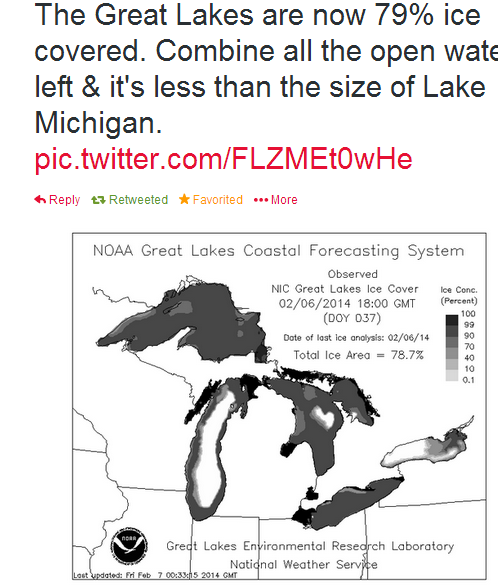
"Global Warming on Steroids" - The Great Lakes are now 79% ice covered.HT: Anthony Farnell.
Combine all the open water left and it's less than the size of Lake Michigan.
Do the Great Lakes freeze in the winter?
The Great Lakes do freeze, but not completely. According to Ray Assel of the Great Lakes Environmental Research Laboratory, ice cover on the Great Lakes varies from lake to lake and year to year. For example, in a year with normal temperatures, 25 percent of Lake Ontario will be frozen over, while up to 90 percent of Lake Erie will be frozen. However, wind and water movement over bodies of water as large and deep as the Great Lakes make it unlikely the lakes have ever frozen over completely for any significant length of time.
The Great Lakes have come close to freezing over completely during the extremely cold winters of 1976-77, 1977-78 and 1978-79, with up to 90 percent ice coverage. However, Assel says that severe winter air temperatures are not necessary for large ice cover on the lakes. A cool summer and fall can result in below normal water temperatures by late fall. Extensive ice cover can then form with only average winter temperatures.
As for the Niagara Falls, the volume and speed of the water flowing over the falls prevents them from freezing, as does the ice-boom at the mouth of Lake Erie. The ice-boom is a series of floating steel pontoons extending across the river from Buffalo, New York to Fort Erie, Ontario. It prevents ice from clogging the river and hydroelectric intakes by helping an "ice bridge" (a stable ice cover) to form at the mouth of Lake Erie. Before the installation of the ice-boom in 1964, the American side of the falls froze over in 1909, 1938 and 1949 because ice jams upstream reduced the water flow. Ice bridges can also form below the falls when ice goes over the falls and freezes to the edges of the gorge, resulting in a buildup of ice (as thick as fifty feet in some places) stretching across the entire river. For photographs of historical ice bridges on the falls, go to Edsen Breyer's Postcard Museum.
According to the Great Lakes Environmental Research Laboratory.
Let’s look at each individual lake.
Lake Superior - Almost frozen over (92 percent covered with ice).
Lake Michigan - Now 51 percent covered with ice. Coyotes were seen walking on the ice just offshore of Chicago this week. This makes us wonder if the lakes freeze over totally, will animals from Canada be able to cross over Lake Huron or Lake Superior, and enter Michigan.
Lake Huron - Ice cover rocketed up an additional 14 percent this week, climbing to a total ice cover of 86 percent. At that rate, Lake Huron could be almost frozen over, or frozen over by the end of next week.
Lake Erie - The shallowest of the Great Lakes, Lake Erie has an average depth of 62 feet and a maximum depth of 210 feet. It also has the least volume of any Great Lake, with 116 cubic miles of water. So it should come as no surprise that Lake Erie is 96 percent covered with ice.
Lake Ontario - Although Lake Ontario is the smallest Great Lake when it comes to surface area, its average depth of 283 feet makes it the second deepest Great Lake behind Lake Superior. Lake Ontario actually holds more than three times the amount of water when compared to Lake Erie. Lake Ontario is only 32 percent covered in ice.
Will ice continue to grow?
The ice cover should continue to grow at a rapid rate based on temperatures expected in the next few weeks.
It is going to be close, but we may be living in a historic winter with regards to amount of Great Lakes ice.
See entire article, along with photos of individual lakes : http://www.mlive.com/weather/index.ssf/2014/02/great_lakes_added_11_percent_i.html
For a look at current and historical Great Lakes surface and ice cover, go to GLERL's Great Lakes Surface Environmental Analysis pages.Hmmm......So the last time they were completely frozen over was 10,000 years ago at the end of the last Ice age.
Video - Horseshoe Falls in Winter.
